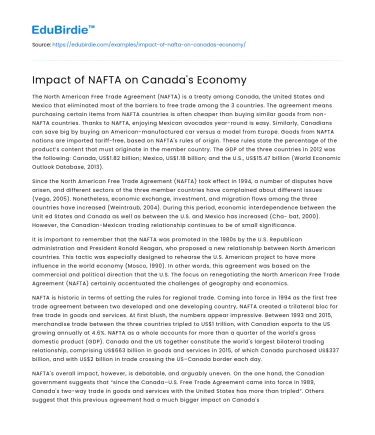The North American Free Trade Agreement (NAFTA) is a treaty among Canada, the United States and Mexico that eliminated most of the barriers to free trade among the 3 countries. The agreement means purchasing certain items from NAFTA countries is often cheaper than buying similar goods from non-NAFTA countries. Thanks to NAFTA, enjoying Mexican avocados year-round is easy. Similarly, Canadians can save big by buying an American-manufactured car versus a model from Europe. Goods from NAFTA nations are imported tariff-free, based on NAFTA's rules of origin. These rules state the percentage of the product’s content that must originate in the member country. The GDP of the three countries in 2012 was the following: Canada, US$1.82 billion; Mexico, US$1.18 billion; and the U.S., US$15.47 billion (World Economic Outlook Database, 2013).
Since the North American Free Trade Agreement (NAFTA) took effect in 1994, a number of disputes have arisen, and different sectors of the three member countries have complained about different issues (Vega, 2005). Nonetheless, economic exchange, investment, and migration flows among the three countries have increased (Weintraub, 2004). During this period, economic interdependence between the Unit ed States and Canada as well as between the U.S. and Mexico has increased (Cha- bat, 2000). However, the Canadian-Mexican trading relationship continues to be of small significance.
Save your time!
We can take care of your essay
- Proper editing and formatting
- Free revision, title page, and bibliography
- Flexible prices and money-back guarantee
It is important to remember that the NAFTA was promoted in the 1980s by the U.S. Republican administration and President Ronald Reagan, who proposed a new relationship between North American countries. This tactic was especially designed to rehearse the U.S. American project to have more influence in the world economy (Mosco, 1990). In other words, this agreement was based on the commercial and political direction that the U.S. The focus on renegotiating the North American Free Trade Agreement (NAFTA) certainly accentuated the challenges of geography and economics.
NAFTA is historic in terms of setting the rules for regional trade. Coming into force in 1994 as the first free trade agreement between two developed and one developing country, NAFTA created a trilateral bloc for free trade in goods and services. At first blush, the numbers appear impressive. Between 1993 and 2015, merchandise trade between the three countries tripled to US$1 trillion, with Canadian exports to the US growing annually at 4.6%. NAFTA as a whole accounts for more than a quarter of the world's gross domestic product (GDP). Canada and the US together constitute the world's largest bilateral trading relationship, comprising US$663 billion in goods and services in 2015, of which Canada purchased US$337 billion, and with US$2 billion in trade crossing the US–Canada border each day.
NAFTA's overall impact, however, is debatable, and arguably uneven. On the one hand, the Canadian government suggests that “since the Canada–U.S. Free Trade Agreement came into force in 1989, Canada's two-way trade in goods and services with the United States has more than tripled”. Others suggest that this previous agreement had a much bigger impact on Canada's economy than NAFTA, that Canada's trade with Mexico is negligible, and that NAFTA's effect on the US itself has been small. From these perspectives, NAFTA appears in need of an overhaul given the deeply uneven effects of free trade. Trump played on such misgivings effectively, portraying NAFTA to rust-belt city voters as being ultimately responsible “for the loss of their high-paying manufacturing jobs”, driven by frequent shifts in production from the US to Mexico.
Key to Canadians is ensuring that trade and investment conditions do not worsen while avoiding any sense of being bullied by Trump (or more diplomatically, pressured). In doing so, they have both vulnerabilities and strengths.
In terms of vulnerabilities, the impact of tariff and non-tariff barriers – if taken across the board – would arguably have a greater effect on Canadian GDP than that of the US. For Canada, bilateral trade with the US is more than 60% of its national total, while for the US trade with Canada constitutes less than 20% of its GDP. Sectoral weaknesses are another problem: including in areas such as softwood lumber, oil and gas exports, and steel. The spike in American natural and shale gas production has proved challenging for Canadian producers. The promised go-ahead by Trump on the Keystone-XL pipeline transiting oil from the Albertan oil sands to US refineries on the Gulf Coast may grant Canada access to other markets for its oil and gas, but against a sluggish market, and in the face of recent US suggestions of transit tariffs.
In terms of strengths, Canada buys more from the US than any other country, it represents the primary commercial customer in 35 US states, and has US$351 million of direct investment in the US as at 2015, with one study suggesting that over eight million US jobs depend on Canadian trade and investment. In diplomatic terms, Canada can also draw on its membership of the (as yet unratified) 11-state Trans-Pacific Partnership (TPP) (from which the US withdrew in January 2017) and its newly ratified Comprehensive Economic and Trade Agreement with the EU. Nailing down a renewed, 'tweaks-only' NAFTA could represent a strong third platform for Canada in international trade. Canadian Foreign Affairs Minister Chrystia Freeland, said that “... the TPP as a deal cannot happen without the United States being a party to it”, but if Canada somehow manages to resurrect it, the country could subsequently position itself as a conduit of Pacific–US–Atlantic trade.






 Stuck on your essay?
Stuck on your essay?

